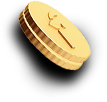Can You Micro Invest Your Way to Wealth?

Once upon a time, we would drop our spare change into a piggy bank or the cup holder of our cars. Then we would use that money to buy some gum or a cappuccino.
Now there are apps that take those extra nickels and dimes and invest them. This type of investing is part of a trend in the finance world dubbed “micro-investing.” But what exactly is this and is it a good idea?
Below, we give you the lowdown on micro-investing, as well as offer some better alternatives.
What Does it Mean to Micro-Invest?
Micro-investing is investing small amounts of money at a time. This is usually accomplished via an app. Most of these apps allow you to get started for as little as $5 or even free.
How the micro-investing happens depends on the app. Some link to your credit or debit card and round up to the nearest dollar when you spend. The difference is then invested in an ETF (exchange-traded fund). Others auto-debit from your bank account or take a cut of your paycheck. You set up the amount or percentage and the money gets invested in a portfolio based on your investment profile.
The idea is to set up the investment process automatically and for the amount to be so small, it’s practically painless. Over time, you could end up investing hundreds, or even thousands, of dollars a year.
The Limits of Micro-Investing
1. Investing spare change does not result in meaningful returns
Some things are great when they’re small: mini-cupcakes, baby chicks and your internet bill, for example. But when it comes to the trend of micro-investing, not so much.
One of the biggest problems with micro-investing is that it can give you a false sense of financial security. You may believe that, because you’re investing, you’ll have enough for retirement. But when you micro-invest, you will most likely yield micro-results. By only investing tiny amounts, you’re missing out on bigger profits.
Let’s say, for example, you use a micro-investing app that rounds up to the nearest dollar on debit card charges and invests the difference. At the end of each year, this spare change may add up to for example $200.
You’re investing like the experts recommend so you don’t need to do anything more, right? Actually, you’ll need to do a lot more!
Compound interest, is the concept of your money working harder for you (i.e. your money earn returns on returns!). Although micro-investing does benefit from compound interest, because of its scale, it simply isn’t enough when it comes to something major like retirement. Building up to a more sizable, proactive saving and investing strategy can help you unlock the tremendous benefits of compound interest to help you achieve your retirement goals.
2. Long waiting periods
Another problem with micro-investing are the waiting periods, both to invest and withdraw.
To invest, you have to wait until you spend or until the money is auto-debited from your checking account. The waiting that occurs in between means you have money that isn’t working for you.
Should you need some emergency funds to pay for a root canal or Fluffy’s vet bill, if the money is coming from your micro-investing app, you’ll have to wait again. The only choice you’ll have is to sell some of your investments and then wait up to ten days for the funds to transfer.
3. Monthly/Annual Fees
Finally, most micro-investing platforms charge monthly or annual fees. Currently, the more popular apps charge either $1 a month, .025% of your investment total or both. These fees may seem cheap but they are extremely high if you have lower balances in your account.
The waiting periods, fees and financial limits of micro-investing may not seem like a big deal. But the long-term impact of these limitations really add up.
How to Build a Better Nest Egg
Micro-investing simply isn’t sizable enough to fund your future. Here at Finch, we want to help you build a nest egg that a bald eagle would envy.
We advocate creating a budget and using the Finch checking and investing account to actively grow your funds.
Unlike micro-investing platforms, the Finch account has no waiting periods. The money in your checking account continually earns investment returns from the start. You can also withdraw instantly, at any time. There are also no minimum deposit requirements or fees to get started.
See The Difference
Let’s say you choose micro-investing as your plan to save for retirement. You opt for that app that automatically invests your spare change.
The spare change you invest probably won’t equal a ton–we’ll go with the total mentioned above, $200 a year. Your micro-investing app charges $1 a month so at the end of each year, you’ve saved around $188. This means over ten years, you would have invested approximately $1,880 of your own money. Assuming your ETF earns a respectable 8% a year, you would have around $2,941 at the end of the decade. As a result, you would have an extra $941 at the end of the decade.
Your friend, who is so responsible she flosses every day, also decides to start investing. However, she wants more meaningful returns and so she skips micro-investing and opens a Finch checking account instead. Through budgeting, she is able to set aside $2,000 each year to invest. This means over ten years, she would have invested approximately $20,000 of her own money. Assuming she earns 8% on her investments as well, her total at the end of the decade would be around $31,291. As a result, she would have an extra $11,291 at the end of the decade! By investing a meaningful amount, she has further unlocked the benefits of compound interest, and her money has worked harder for her, dollar for dollar!
Also, the example above doesn’t take into consideration the extra returns your friend earns due to no wait times. Remember that with Finch, her money is invested the moment it settles in her checking account. With the micro-investing apps, there’s a delay. Over time, this would make an even larger difference.
The Bottom Line
Investing something is certainly better than investing nothing. That said, micro-investing alone won’t be sufficient for helping you attain your long-term financial goals. If anything, micro-investing should be considered a companion technique to your more proactive investment strategy. If you do use micro investing apps, be sure to include other tools like Finch in your overall investment strategy. Finch lets you earn investment returns on your every dollar, while keeping access to all of your money so you can build your nest!








